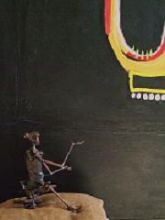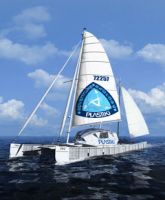Tussen de bioluiers en de set
Filmwereld snuffelt aan milieubeleid
George Clooney heeft een hybride auto. Julia Roberts bovendien ook zonnepanelen op haar dak, biologisch eten op tafel, en haar babies hadden bioluiers om de bips. Leonardo DiCaprio pakt graag de fiets, maakt klimaatfilms als “The Eleventh Hour” en heeft zijn eigen milieuclub opgericht. Daryl Hannah gaat uit walvisredden met Sea Shepherd’s Paul Watson of ketent zich doodleuk vast aan bomen die met kappen worden bedreigd. En Cameron Diaz? Die spaart water. Spoelt gewoon de WC niet altijd door….
We spreken medio 2010. Een béétje Hollywood-ster doet tegenwoordig aan milieu. "Wij zijn wereldwijde rolmodellen, nietwaar..." Nou ja, de één is consequenter dan de ander: niet iedereen zegt zijn privé jet of haar swimming pool vaarwel. En hoe zit het eigenlijk met de hele filmproductiemachinerie, waarvan de celebs het boegbeeld zijn?
 Wel eens stilgestaan bij het afval en het energiegebruik, waarmee een bioscoopkaskraker gepaard gaat? Houten en piepschuim decorstukken, megalampen, hele crews die per vliegtuig naar afgelegen filmlocaties suizen. Ruim 41.000 ton afval produceren de gezamenlijke Hollywoodstudio’s ieder jaar, evenals 8 miljoen ton broeikasgas CO2.
Wel eens stilgestaan bij het afval en het energiegebruik, waarmee een bioscoopkaskraker gepaard gaat? Houten en piepschuim decorstukken, megalampen, hele crews die per vliegtuig naar afgelegen filmlocaties suizen. Ruim 41.000 ton afval produceren de gezamenlijke Hollywoodstudio’s ieder jaar, evenals 8 miljoen ton broeikasgas CO2.
Verbluft
In Europa hoef je de vraag naar zulke cijfers niet eens te stellen. “Milieubeleid? …uhh”, hakkelt bestuurslid Jeanette Kolkema van het Nederlandse Regisseursgilde verbluft. Op vakwebsites over de Europese filmwereld ook al geen woord over milieu. Evenmin over mensenrechten, overigens.
Dat er in de V.S. wèl milieucijfers bestaan – zij het uit 1997 – is te danken aan de Staat Californië, die in 1989 met pittige afvalwetgeving de filmstudio’s tot actie dwong. Stapje voor stapje is sindsdien een kring van milieubewuste leveranciers, consultants en burgerinitiatieven rond het filmbedrijf ontstaan.
Schwarzenegger
Ging het begin jaren negentig nog over simpele zaken als afval (hout en plastic) en kringloop-kantoorpapier, langzamerhand is het blikveld verbreed. Nu komt de ene na de andere filmstudio met langetermijn-plannen. Energie en klimaat zijn ‘hot’, mede doordat Californië’s Republikeinse gouverneur Arnold Schwarzenegger – eerijds filmheld, nu milieuridder - stevig inzet op duurzame energie.
Dat begint vruchten af te werpen, zegt de Motion Picture Association of America (MPAA). In 2007 hebben de grote Amerikaanse filmmaatschappijen gezamenlijk 20.862 ton filmafval ingezameld voor hergebruik, 57% van hun vaste afval. Dat scheelde 65.497 ton uitstoot van het broeikasgas CO2. Dat is het equivalent van 14.176 auto’s per jaar. In 2008 werd nog eens 18.300 ton afval bij de stortplaats weggehouden, een besparing van 33.797 ton CO2, oftwel de uitstoot van 7.315 auto’s.
Geen blauwdrukken
Niet iedereen is overtuigd. “Er is nog heel wat ‘greenwashing’, lege groenpraatjes”, zegt producer/regisseur en milieuveteraan Scott McKinlay van het Hollywood Green Team. Anderen zijn milder. “Geef de studio’s tijd om te experimenteren”, vindt directeur/eigenaar Laura Selman (23!) van het milieuadviesbureau Reel Green Media.
 Ann Burkart van Sony Studio’s, benadrukt dat het feitelijke productieproces opgroenen een ingewikkeld karwei is. “Voor milieuzorg in kantoren bestaan blauwdrukken, maar productiecrews zijn samenraapsels van ingehuurde lieden. Special effect-mensen, stuntmannen, licht en geluidexperts. Niet eenvoudig te sturen…. Toch hebben we hebben een goed gevoel over hoe we bezig zijn.”
Ann Burkart van Sony Studio’s, benadrukt dat het feitelijke productieproces opgroenen een ingewikkeld karwei is. “Voor milieuzorg in kantoren bestaan blauwdrukken, maar productiecrews zijn samenraapsels van ingehuurde lieden. Special effect-mensen, stuntmannen, licht en geluidexperts. Niet eenvoudig te sturen…. Toch hebben we hebben een goed gevoel over hoe we bezig zijn.”
Verwante stukken (related stories English: upcoming):
Sony's "zero waste"
Minder stupid
RTV goes a-treehuggin'
http://www.biosagenda.nl/nieuws_voor-groene-films-moet-je-in-amerika-zijn_2445.html
http://www.biosagenda.nl/nieuws_groene-revolutie-binnen-de-omheining-van-hollywood_2452.html
http://www.biosagenda.nl/nieuws_digitaal-zorgt-voor-milievriendelijkheid_2464.html
http://www.biosagenda.nl/nieuws_zelfs-verhuizen-gebeurt-groen_2485.html
http://www.biosagenda.nl/nieuws_naar-zero-co2-voet-afdruk_2502.html
http://www.biosagenda.nl/nieuws_bollywoods-eerste-ecostappen_2747.html
http://www.biosagenda.nl/nieuws_aardbeipremiere-de-eco-filmrace_2905.html
Martial Art

Once they were bullets, pistols or grenades. Now under the deft hands of Mozambique’s possibly most famous sculptor Goncalo Mabunda they have been transformed into Art.
Recycling AK-47's and other arms from the one-time civil war has become the trade mark of Mabunda and a couple of his fellow artists. I saw some of the results in a small B&B in Antwerp. But even the British Museum and the Bill Clinton Foundation acquired pieces from the 'Arms into Art' programme. Read more…
Photo: © Michel Robles
High on FSC

Ten years ago the Netherlands were an admired environmental pioneer nation. Nowadays, due to a shortsighted neoliberal policy we are almost tail-end Charley within the European Union. Belgium, on the other hand, is a real runner-up. Last December (2010) the Flemish Leukenheide distillery presented Dennenknopje (Pine Bud). Dennenknopje is the world’s very first jenever (traditionally a truly Dutch strong drink), made from a Forest Stewardship Council (FSC) labeled wood product. The gin-like softbooze is distilled from pine cones from the Pinus silvestris. The pines grow in Flanders’ vastest, FSC certified forest region Bosland. A local high from an okay forest. Innovation can be anywhere.…
Questioning Plastiki pride
The newly designed cradle-to-cradle catamaran Plastiki has recently arrived is Sidney after a publicity voyage from California across the Pacific Ocean. The designers claim extreme recyclability. But, contrary to earlier announcements, the ship will not be up-cycled now that it has reached its destination. The builders say they've become too attached to their newborn baby. Of course, the vessel can be a showcase for years to come. But, hey, isn't this kind of attachment of people to their achievements precisely the reason why our earth is becoming such a cluttered place? www.theplastiki.com

Sweet C2C
Cradle-to-cradle handmade beauty: go haunt the town's antique and recycle shops and flea markets for a bunch of elegant (or maybe you prefer funny or modern design) plates, saucers and wine glasses. Wash them well, sand the glasses' brims lightly and glue things together with strong porcelain glue. Any shape, size and design you fancy, will do.


Lo and behold: you have now created your own home grown bonbonnière! For sweets, cookies, fruit - or sandwiches if you like. Ladies love'em! Dozens were sold in a fashion shop in my home town. Enjoy more...

Photos: © Michel Robles
Links
Novio Design Webdesign
